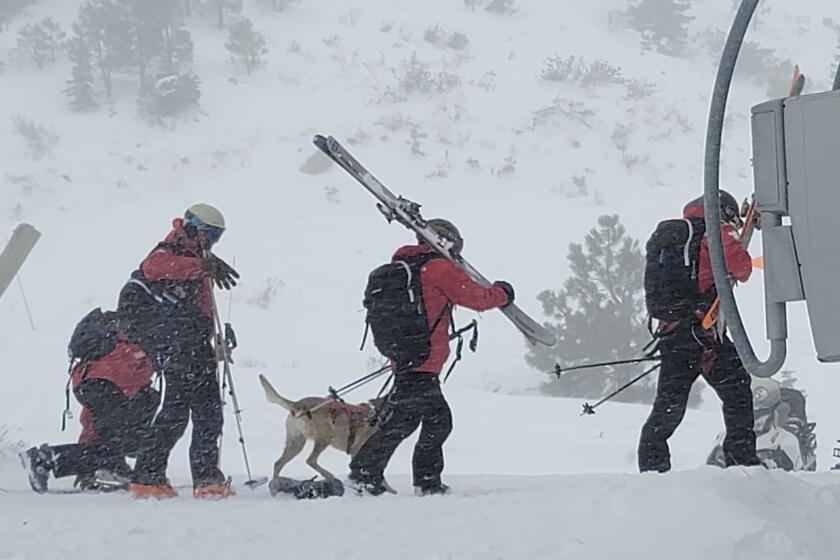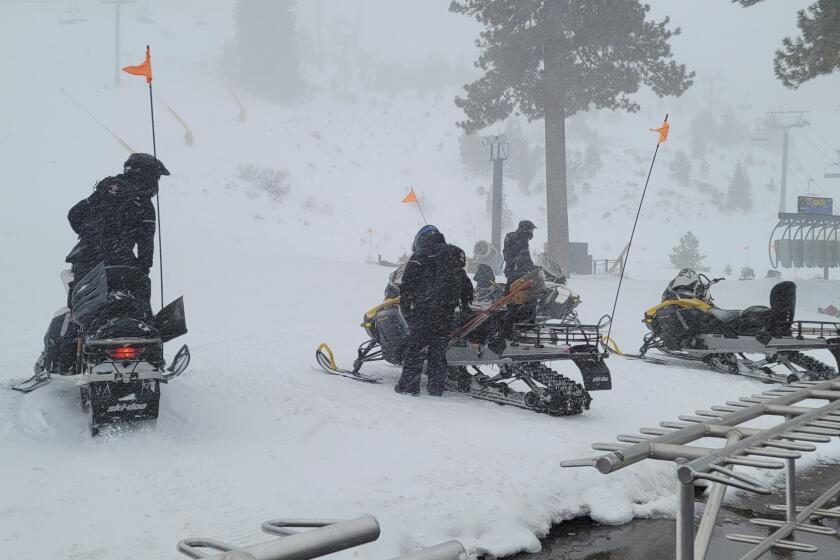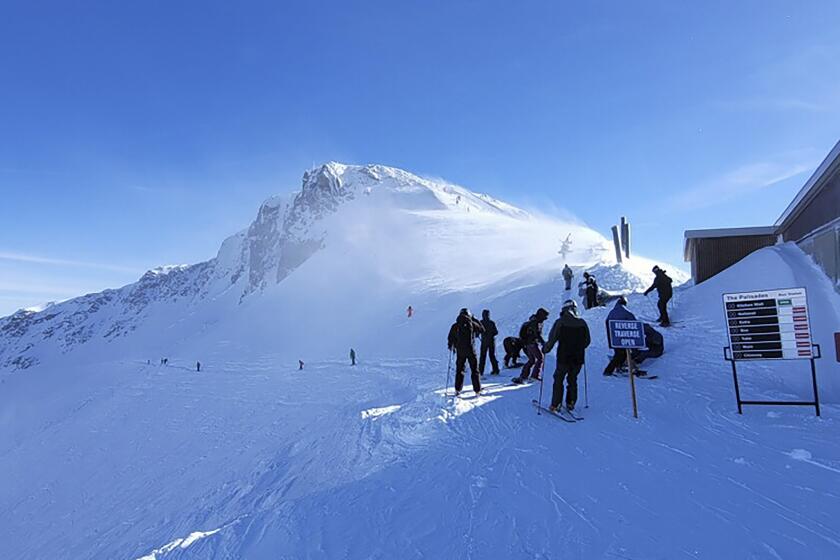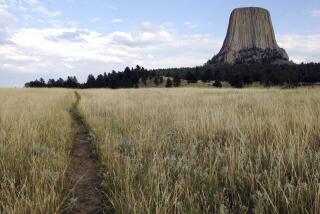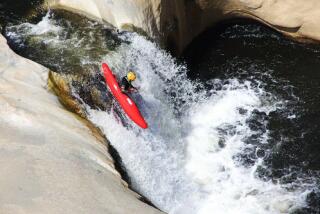Palisades Tahoe avalanche survivor was minutes from death before rescue. ‘I just felt the snow hit me’
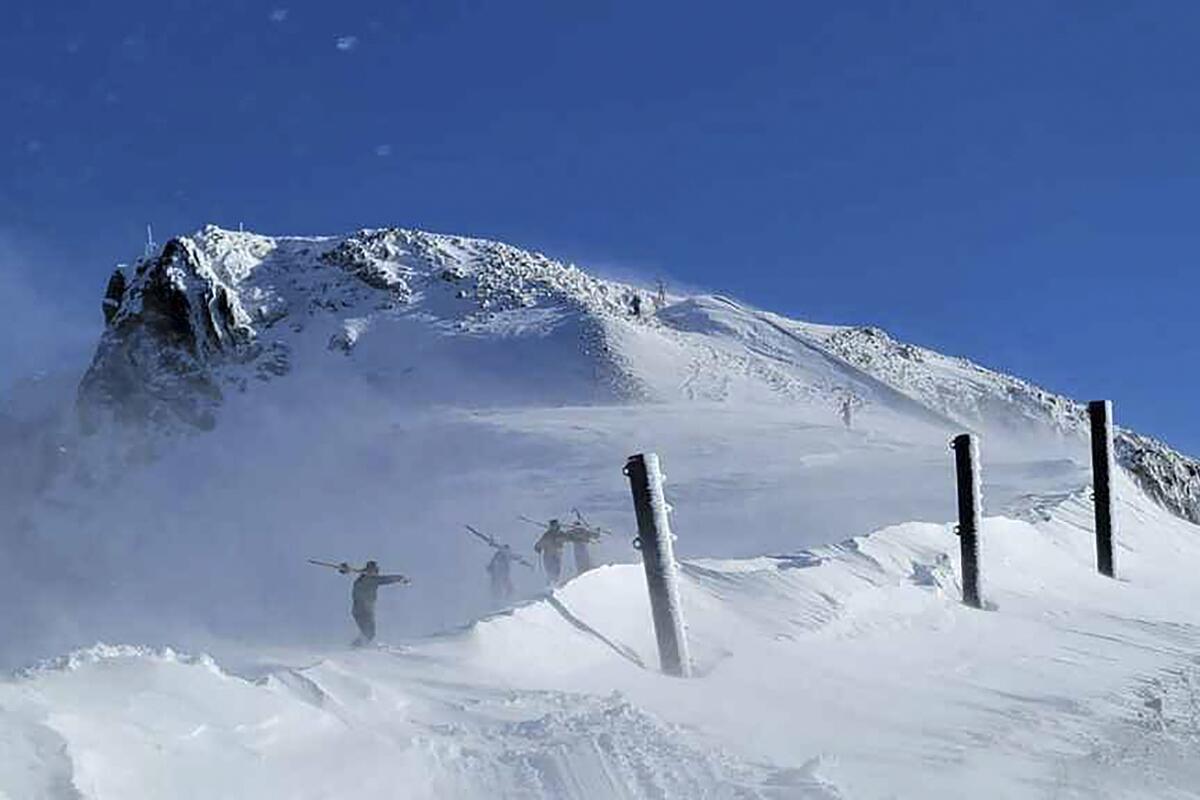
The first sign of trouble came in the form of a spray of snow, rolling down from above where Jason Parker had come to a stop near the top of one of California’s steepest and most famed ski runs — the face beneath Palisades Tahoe’s KT-22.
He didn’t think much of it. “OK,” he remembers thinking. “Maybe there is a skier above me who just triggered a little bit of snow.”
Parker didn’t hear a roar or a crack. The wind was blowing, and all his ears picked up was a howl, blowing across the ice face and whipping gusts of fresh powder toward the base of the mountain far, far below.
This was pretty standard, and he prepared to continue down the mountain.
“I didn’t hear it,” he said of what happened next. “I just felt the snow hit me … flipped me onto my back.”
The three-day holiday weekend and several inches of new snow are likely to draw crowds to the mountains, days after a rare avalanche at the Palisades Tahoe resort killed a skier.
From a safer position several yards away, his fiancée heard him say: “Oh, s—.”
Parker doesn’t really remember that. He was “in a river, flowing down.” Except it wasn’t a river. It was an avalanche, one that was in the process of claiming the life of one man, Kenneth Kidd, 66, a skier who split his time between Marin County and Truckee.
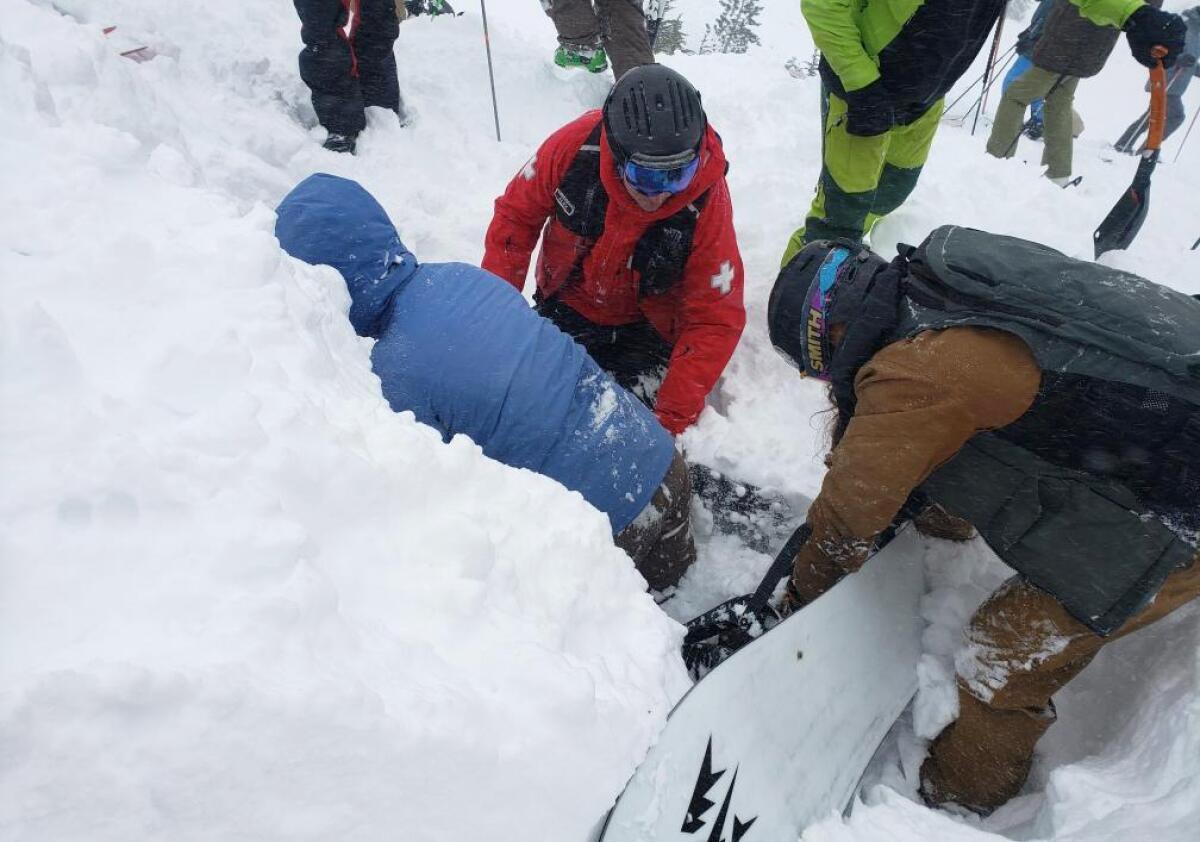
And now Parker was caught up in it as well. He felt his body accelerating. He felt snow massing above him.
He screamed “Watch me! Watch me!” He knew it would be important to have some idea where he ended up, so rescuers could come get him — he didn’t have a beacon on him.
But beyond that, there was nothing to do but let the river of snow take him, snowboard and all, and sweep him down the mountain as skiers on the lift above watched in horror.
Parker knew the terrain beneath KT-22 well. He’d ridden it countless times in his decades of coming to Palisades. He knew how steep it was. He knew there was a chute just below him, surrounded by sharp outcroppings of granite. Being swept through the chute would be good. If he was tossed over one of the outcroppings, that would be bad. Traumatic injury bad. Multi-story plunge bad.
The river of snow swept him through the chute. This was good. Sort of. But it was also not good, because his body began to accelerate. Somehow he was flipped onto his stomach, face-first down the mountain, his snowboard still attached to his feet.
Wednesday’s avalanche forecast by the Sierra Avalanche Center said there was a high risk of two types of avalanches in the area.
Meanwhile, as he and the avalanche plunged ever down, more and more snow became compacted around his body.
Finally, as the angle of the slope lessened, he felt himself come to a stop.
“I’m thinking, I’m gonna be OK,” he said. “Man, this is going to be OK.”
Except it wasn’t.
Because Parker was entombed in about 4 feet of snow, invisible to the dozens of people who by now had amassed on the face of the mountain to look for survivors.
He couldn’t move. Not his legs. And not his arms. Soon, he would run out of oxygen.
More than most other people on the slopes at Palisades Tahoe that morning, Parker understood the dangers posed by avalanches, rare though they may be in places like Palisade’s runs.
In the last decade, 244 people have died in avalanches in the U.S., according to statistics from the Colorado Avalanche Information Center. The vast majority involved people in backcountry areas or what is called “sidecountry” — where they ducked ropes or otherwise wandered beyond resort property into adjacent terrain.
Only six skiers and snowboarders have died in avalanches on open resort runs over the last 10 years. Three of those died in a single 2020 incident at an Idaho resort.
Parker, 52, has a day job as the transportation manager at Silver Legacy Resort in Reno. But in the winter, his spare time is spent snowboarding — at Palisades, where he has a season pass, and also in the backcountry, where he goes to avoid the crowds and enjoy the solitude of snow, sky and occasional views of mighty Lake Tahoe from peaks such as Mt. Tallac and the Carson Pass.
Like many backcountry riders, he had also taken courses in how to survive avalanches.
He knew the stark number: Rescuers had about 15 minutes to find him before it would be too late.
Deadly avalanches far more commonly strike in the backcountry, not within the boundaries of a ski resort like Palisades Tahoe that once hosted the Olympics and boasts robust avalanche operations.
Somehow, before his arms became completely sealed up in snow, he punched a small air pocket in front of his face. It would give him a few minutes of oxygen, he figured.
He did it just in time. “The rest of the slide was still coming,” he recalled. “So it just entombs me.”
Everything went black.
At first, he screamed for help. But after a few minutes, he stopped, knowing he needed to conserve oxygen.
He lay in the blackness, alone.
“It’s weird. I don’t know how to explain this,” he said. “I really did just slow my breathing, and then I started telling myself: ‘I think this is it.’”
“I kind of made peace with it.”
His fiancée, his family and his friends drifted through his mind. He could feel himself losing consciousness. He knew it was because he was breathing carbon dioxide, but in the moment it felt as if he was in a dream.
He was surprised by how calm he felt.
Until, suddenly, he felt a sharp poke to his back — a rescuer’s probe.
“It awakened me,” he said. He felt a wave of emotion. “I’m going to be OK,” he thought again, for real this time. “They’re going to get me.”
As if from far away, through layers of snow, he heard a voice yell: “I’ve got him. We found him!”
He heard more voices. He heard the sound of frantic digging. Someone made an airway for him. He gulped in fresh air.
He was still buried, but there were dozens of people now, some digging with gloved hands and some with shovels, trying to rescue him.
Finally, they got him out.
His fiancée threw herself into his arms.
A member of the Palisades ski patrol was there. What is your name, the rescuer asked. Do you know where you are? Are you hurt?
He answered their questions. He knew where he was. He wasn’t really hurt — although he could feel that one of his knees was hyperextended. It hurt, but not horribly.
Members of the ski patrol offered to carry him off the mountain.
But he could see all around him a frantic search. By now there were snowmobiles and rescue dogs, everyone looking for more victims. And he had tweaked that knee before; he thought he could snowboard on it.
No, he said he told them, I don’t need a toboggan. I’ll ride down.
That is what he and his fiancée did.
When they reached the bottom of the hill, the resort had started to empty out.
Parker and his fiancée (who Parker said doesn’t want anything to do with media interviews) made their way to their car.
No one tried to stop them.
He drove them back to Reno. “Adrenaline,” he said when asked how he did it.
It wasn’t until he was home that he heard that another skier had died.
“It just broke my heart,” he said. “How did I come out so unscathed? And this guy passed?”
A day later, the media found him.
Parker agreed to interviews. In each and every one, he delivered a safety message: Know the dangers, he said.
“The mountain isn’t Disneyland.” If you know you’re skiing with avalanche danger, carry a beacon, even at a resort, where such accidents are rare.
Three other resort guests were swept up by the avalanche at KT-22. Kidd was killed and two others were caught in the slide but rescued by bystanders, authorities said. The cause of the avalanche is under investigation; it happened right before a winter storm dumped several feet of snow on the Tahoe region.
Other survivors also recounted how they escaped the avalanche.
Janet He and her husband, Joseph Lu, wanted to be among the first people on KT-22 when it opened. The couple were going down the run when the avalanche happened — and swept He down the mountain.
She fell about 200 feet and was buried under the snow, she told CBS13 in Sacramento.
“I couldn’t pull myself up because the snow was so heavy on top of me,” she said. “I was buried, my face buried in the snow. I’m lucky I had the face mask, I had some air in the face mask.”
While Lu frantically looked for his wife, He tried to remain as calm as possible. Then she heard a voice coming from above. A skier had come to her rescue and helped pull her out of the snow.
“He says, ‘No worries, I got you,’” she said. “I think that’s the best thing I ever heard in my life.”
Other ski resort guests went to the rescue when they heard about the avalanche.
Jeremy Jones was snowboarding with his 15-year-old son on KT-22 Wednesday morning . They were on their second run when Jones lost sight of his son, according to his social media post.
When Jones got to the bottom, he heard, “There was an avalanche. Lift is closed.”
Feeling nervous, Jones called his son, who told him he had rushed to the scene of the avalanche and had helped out a guy who had been hurt. Jones’ son gave the man his gloves and jacket until ski patrol arrived.
Jones went over to see how he could help and learned that a buried snowboarder had been rescued but that another person had died .
“My heart bleeds for the friends and family of the deceased,” Jones wrote in his post. “Gratitude to the community effort on the rescue.”
Parker said he holds Palisades blameless for the accident.
“I’ve been skiing at Palisades for so long,” he said. “It’s family up there for me.”
He called its public relations phone number and left a message.
On Friday morning, someone called back.
He told them he wanted to come back. He wanted to ski KT-22 again.
Palisades officials told him, he said, that when that happens they’ll send ski patrol up with him.
More to Read
Sign up for Essential California
The most important California stories and recommendations in your inbox every morning.
You may occasionally receive promotional content from the Los Angeles Times.
